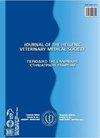Oscar鱼(Astronotus ocellatus)肠道嗜酸性颗粒细胞的密度、分布和染色特性
IF 0.4
4区 农林科学
Q4 VETERINARY SCIENCES
引用次数: 1
摘要
鱼类嗜酸性颗粒细胞存在于与外部环境相关的结构的结缔组织中。这些细胞在结构和功能特征方面与哺乳动物肥大细胞相似。这些细胞的细胞质颗粒根据固定剂的类型给出不同的染色反应。本研究旨在使用不同的固定剂和组织化学技术测定Oscar fish(Astronotus ocellatus Agassiz,1831)肠道中嗜酸性颗粒细胞的染色特性和密度。福尔马林和碱性醋酸铅固定giemsa染色显示,嗜酸性颗粒细胞在肠前丰富,尤其局限于血管和粘膜下层。Bouin固定剂的Giemsa染色比其他固定剂显示嗜酸性颗粒细胞在后肠中更高。在任何固定剂中的硫蛋白和甲苯胺蓝染色中,在嗜酸性颗粒细胞中均未观察到反应。用不同固定剂固定的样品中的嗜酸性颗粒细胞具有异色阿尔西安蓝染色。总之,本研究表明,固定剂可能对Oscar鱼肠道嗜酸性颗粒细胞的分布和染色特性有不同的影响。肠前和粘膜下血管周围的丰富性表明,嗜酸性颗粒细胞可以在黏膜免疫中对食源性病原体发挥积极作用。本文章由计算机程序翻译,如有差异,请以英文原文为准。
Density, Distribution and Staining Properties of Eosinophilic Granular Cells in Oscar Fish (Astronotus ocellatus) Intestine
Fish eosinophilic granular cells are found in the connective tissues of structures associated with the external environment. These cells are similar to mammalian mast cells in terms of structural and functional characteristics. The cytoplasmic granules of these cells give different staining reactions depending on fixative type. This study aimed to determine the staining properties and densities of eosinophilic granular cells in Oscar fish (Astronotus ocellatus Agassiz, 1831) intestine using different fixatives and histochemical techniques. Formalin and basic lead acetate fixation-giemsa staining indicated that eosinophilic granular cells were abundant in anterior intestine, localizing around especially the blood vessels and submucosa. Giemsa staining of Bouin’s fixed rather than other fixatives showed that eosinophilic granular cells were higher in posterior intestine. No reaction was observed in eosinophilic granular cells in Thionin and Toluidine Blue staining in any fixative. Eosinophilic granular cells in samples fixed with different fixatives had metachromatic Alcian Blue staining. In conclusion, this study shows that fixatives may have different effects on the distribution and staining properties of eosinophilic granular cells in Oscar fish intestinal regions. Abundance in anterior intestine and around submucosal blood vessels shows that eosinophilic granular cells could play an active role in mucosal immunity against food-borne pathogens.
求助全文
通过发布文献求助,成功后即可免费获取论文全文。
去求助
来源期刊

Journal of the Hellenic Veterinary Medical Society
VETERINARY SCIENCES-
CiteScore
0.60
自引率
0.00%
发文量
83
审稿时长
>12 weeks
期刊介绍:
The Journal of the Hellenic Veterinary Medical Society (J Hellenic Vet Med Soc) is a quarterly peer-reviewed journal that publishes articles in all aspects of veterinary science and related disciplines. It is published by the Hellenic Veterinary Medical Society and is indexed in the Web of Science and in Scopus.
There are no publication fees in the journal. Authors considering submitting manuscripts for evaluation and publication are requested to read carefully the instructions for authors and fully comply with them.
Non-complying manuscripts may be returned to the corresponding author for formatting.
 求助内容:
求助内容: 应助结果提醒方式:
应助结果提醒方式:


